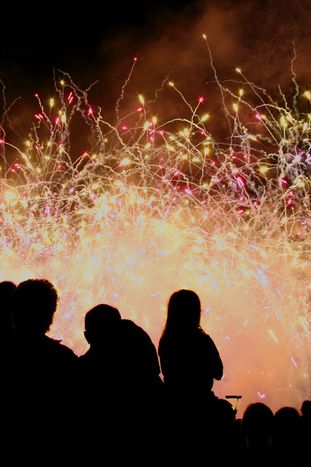
Europeans who celebrate New Year’s Eve - on 30 December
Published on
Translation by:
 Kate Stansfield
Kate Stansfield
One fine day, two Spaniards and an Italian decided that they were tired of always spending New Year’s Eve doing the same thing. The Old Continent awaited, along with many people to meet. See out the year European-style!
The day? 30 December. The time? 8pm. The place? Tacheles Bar, number 54, Oranienburger Street, Berlin. The colour of the t-shirts? Green.
That’s all you need to know to take part in a different way of spending New Year’s Eve: travel round Europe and meet people from all over the world, the alternative devised by a few Spaniards who were fed up of the typical seasonal parties …
In summer 2006, Juan Antonio Gonzálvez and Antonio Aguilella, who were holidaying in Iceland, asked themselves over a drink why it was always just them who took that kind of trip and how they could include more people. The place wasn’t important. After pondering for a while, inspiration struck: Why don’t we spend next New Year’s Eve in Amsterdam? That was that. They sent an email to their network of friends, who forwarded it in turn to their own contacts. The more the merrier. They hoped to get around ten people together, but the thing ended up taking on a life of its own: on 30 December, 63 red T-shirts gathered in Dam square in the Dutch capital. They all had the same goal: to have the best time possible with a large group of strangers… to begin with.
No itinerary
And why the 30th when New Year’s Eve is the 31st? Very simply to break the ice and get to know each other a little before the big party. Not to mention to have chance to discuss where to go the following day to celebrate the start of year, of course. Because the trick of it is that there is nothing planned. The event doesn’t even have a name. The ‘organisers’ don’t even know how many people will turn up. It is all down to improvisation. It’s all very Spanish.
Emiliano Bruno, the Italian third member of the organising committee, works at the European commission. Bruno points out that this kind of initiative doesn’t go down well with other European cultures. 'Here in Luxembourg a lot of people, when they asked me about this event, couldn’t get their head around how we hadn’t rented a venue, and how there were no ‘organised’ activities… Needless to say, those people didn’t sign up. There were even some slightly disdainful smiles about the plan of ‘those Spaniards…'. Here, they don’t understand anything circle-shaped: if there are no squares, there’s nothing.'
Multiculturalism
Fortunately, not everyone thinks alike in Europe. '2008 will be the year when it leaps to international level,' Antonio Aguilella assures us. In 2006 and 2007 there were mostly Spanish, though there were also Italians, Germans, Belgians and one Chinese person. In 2008, Polish, Argentinian, Mexican, Irish, British, Dutch and Swedish nationalities are joining in. 'In that way, Emiliano has become a real recruiter, since he is in direct contact with people from many countries,' adds Aguilella.
27 year-old Malgosia Grudzien, from Poland, will take part this year for the first time. She heard about the event from a Spanish friend currently living in Poland and immediately liked the idea of a change of scene for once. 'I hate New Year’s Eve. It seems such a drag… The fact that you have to enjoy yourself, you have to go out… Why? Isn’t it just another day like any other?' Grudzien asks herself, expecting nothing more from this celebration than to meet people and have the best time possible.
New friendships and more
Of course, the party doesn’t stop on 1 January with everyone going their separate ways. Many of them meet up at other times of the year in their respective cities, to have a drink or go out partying.
It could be said, with no exaggeration, that for some this way of experiencing New Year’s Eve has brought a big change to their lives. If swearing eternal fidelity before a few witnesses can be considered a life-changing event.
Translated from Fin de año a la europea: celebra Nochevieja y no mires con quién


